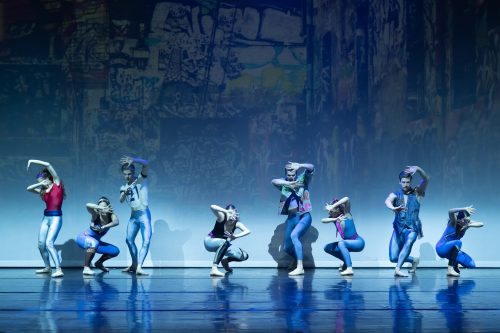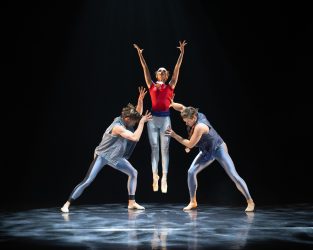 United Kingdom New English Ballet Theatre’s Genesis Dance Project and New Works: Lilian Baylis Theatre, Sadler’s Wells, London, 2.11.2023. (JO’D)
United Kingdom New English Ballet Theatre’s Genesis Dance Project and New Works: Lilian Baylis Theatre, Sadler’s Wells, London, 2.11.2023. (JO’D)

Baroque Encounters
Choreography – Daniela Cardim
Music – Johann Sebastian Bach
Costume design – April Dalton
Lighting design – Andrew Ellis
Dancers – Ana Freire, Genevieve Heron, Tamara Hinson, Casey Nokomis Pereira, Noah Benzie-Drayton, Eric Caterer-Cave, Dan Corthorn
All in Passing
Choreography – Peter Leung
Music – Nicholas Thayer
Costume design – Peter Leung and Sara Mackenzie
Lighting design – Andrew Ellis
Dancers – Livi Boyd, Alice Higginbottom, Casey Nokomis Pereira, Dan Corthorn, Noah Benzie-Drayton, George Leatherby, Nicholas Vavrečka
Genesis Dance Project
Choreography – Ruth Brill (The Cinema Show), Wayne Eagling (Ripples; Watcher of the Skies), Kristen McNally (I Can’t Dance; Invisible Touch) and Valentino Zucchetti (Firth of Fifth)
Music – Genesis
Costume design – Nina Kobiashvili
Lighting design – Andrew Ellis
Dancers – New English Ballet Theatre
From the place ‘where ballet and contemporary dance meet’ New English Ballet Theatre presents six dances by four choreographers to the songs of the rock band, Genesis. The Genesis Dance Project itself forms the second part of the evening. The first consists of new works by choreographers Daniela Cardim and Peter Leung. Across the eight pieces of dance, and their different dance styles, what remains a constant pleasure is the skill and dedication of the New English Ballet Theatre dancers.
Inspired by Johann Sebastian Bach’s music for harpsichord, Daniela Cardim’s Baroque Encounters puts them in tight-fitting, sleeveless tops and voluminous skirts for a piece that makes reference to the chiaroscuro of Baroque painting (also present in Andrew Ellis’s lighting) and emphasises the dancers’ supple arms and backs. Peter Leung’s All in Passing, performed two months ago in the first of Jamiel Devernay-Laurence’s Ballet Nights at Canary Wharf, employs edgier music, by Nicholas Thayer, and an edgier movement vocabulary based on improvisation and touch.
For the Genesis Dance Project, costume designer Nina Kobiashvili draws on denim, headscarves and glitter for a retro vibe. Video footage for the opening piece, Wayne Eagling’s Watcher of the Skies, provides a background of smoke-filled, urban grittiness to a group of dancers first seen playing with a football as if on a ‘vacant lot’. Soon, though, the pointe-shoe-wearing women organise themselves into a kind of corps de ballet, and Wayne Eagling’s experience as a classical ballet dancer in the work of Frederick Ashton, for example, begins to show. It becomes more evident still in his second piece, Ripples, a pas de trois, with skimming lifts, for a woman and two men.

The huddled dancers of Kristen McNally’s I Can’t Dance, on the other hand, bring Hofesh Shechter to mind. McNally, as a member of The Royal Ballet, has performed in work by that choreographer. But instead of Shechter’s trademark stomp sur place, the dancers here begin to thrust their hips in languorous unison. McNally’s second piece, Invisible Touch, is less successful for being all on one note: two upright dancers moving rapidly back and forth on rigorous demi-pointe, in close proximity but with no physical contact.
Taking the names ‘Romeo’, ‘Juliet’ and ‘Tiresias’ from the lyrics of The Cinema Show, Ruth Brill constructs a narrative piece. Again, and testimony to Ruth Brill’s work as a dancer with Birmingham Royal Ballet, dancers in black form themselves into a corps around the hero, the heroine, and the mysterious, cloaked figure who appears to control their fate.
Valentino Zucchetti, a First Soloist with The Royal Ballet, first collaborated as a choreographer with New English Ballet Theatre in 2014. His aim in the Genesis Dance Project, using the song Firth of Fifth, is to recreate ‘that afterparty atmosphere you get once the club shuts down’. He achieves this most effectively during Steve Hackett’s extended guitar solo towards the end, when Andrew Ellis makes the light go red and dancers stand at the sides of the stage watching other dancers, as they do in the work of Alexei Ratmansky and Kenneth MacMillan.
John O’Dwyer
